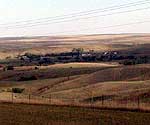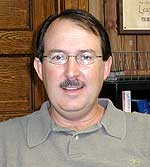By Cara Hetland
Minnesota Public Radio
October 1, 2002
Buffalo County, S.D., is the nation's poorest county. The 2000 census says Buffalo County has more poor children than any other county in the nation. The latest round of census numbers show us how many homes don't have kitchens, plumbing and telephones. In Buffalo County the number of homes without those basic services is increasing.
Most of Buffalo County is made up of the Crow Creek Indian reservation. It's one of the few rural South Dakota counties that has more children now than 10 years ago. Community leaders are looking at how to change things. But it'll take time.
| |
|
|
|
||
Buffalo County is vast and barren. Rolling hills border the Missouri River. Power lines, which still run above ground, connect homes and small communities. There's about one house for every mile in Buffalo County.
Fort Thompson is the largest town. There are a few clusters of houses. The makeshift neighborhoods are rundown, and faded newspapers, tin foil or old sheets cover the windows.
Vicki Lambert has lived in Fort Thompson for 20 years.
More than 70 percent of the residents are unemployed, but not Vicki Lambert. She works in the supply room at Indian Health Services. Lambert says she's not really surprised her county is the poorest in the nation.
"The only way for me to continue to contribute to keeping that number down is to stay employed and provide for my family. That's the biggest contribution that I can make," says Lambert.
Lambert says she encourages her eight children to get an education, and then come back to the reservation to make a difference. She feels it's their duty.
| |
|
|
|
||
But looking around, there isn't much for a college-educated person to do. Job options include a gas station, a laundromat and the tribal casino. There are some jobs with the tribal government. But the Crow Creek Sioux tribe is in debt. It doesn't have money to start new businesses or create jobs. Tribal officials did not return phone calls for this story.
Susan Smith sees the effects of poverty on children. As director of the Head Start program, she works with three, four and five-year olds. Smith says as long as she can remember, Buffalo County has had a high poverty rate. Census figures show 21 percent of the homes in Fort Thompson don't have a kitchen or plumbing.
"There are some homes that I know that may not have running water. But more of what I see is lack of housing, multiple family households - sometimes having 15 or close to 20 people in a home," says Smith.
Tribal members say there are some 50-year-old men on the reservation who have never had a job. Even if there were jobs to be had, many residents don't have the skills to keep them. The public school district wants to change that.
| |
|
|
|
||
Thirty miles down the road is Chamberlain, where a lot of reservation kids go to school. In fact, 45 percent of its students are poor, and get free or reduced lunch.
Superintendent Tim Mitchell says poor kids don't do as well in school. The district has seen an increase in state and federal funding to boost test scores, but still, 30 percent of the Chamberlain students fail proficiency tests. Mitchell says teachers have to change the way they teach.
"I hate to admit it, but in our profession we made assumptions about what kids were and were not doing," says Mitchell. "Now we're looking at assessing students, and being very prescriptive about what they do and do not know."
Mitchell says for the first time, the school district will track students based on test scores. That way they'll see who the low achievers are and where they live. Then, teachers can adjust the curriculum for those students.
But there is one problem. Chamberlain only buses kids to school through eighth grade. No one knows how many students go on to attend a tribal high school or drop out.
But Superintendent Tim Mitchell says he knows most of the students from the Crow Creek reservation don't continue at Chamberlain. That's because nearly one-quarter of the people in Fort Thompson don't have a car.
More from MPRMore Information



